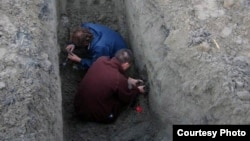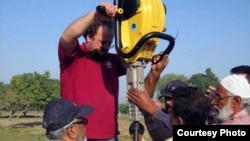Climate change may have hastened the end of the largest civilization in the ancient world, according to a study in the Proceedings of the National Academy of Sciences.
The Indus empire, larger than its contemporaries Egypt and Mesopotamia combined, once held 10 percent of the world’s population and spanned 1 million square kilometers across the plains of the Indus River, from the Arabian Sea to the Ganges, encompassing what is today Pakistan, eastern Afghanistan and northwest India.
Despite its great cities and trade routes, the Indus civilization disappeared some 3,000 years ago and was nearly forgotten until the 20th Century, when archaeologists began unearthing its lost treasures.
Unlike the Egyptians or the Mesopotamians, the Indus didn’t build large temples or pyramids. Lead author Liviu Giosan, a geologist at the Woods Hole Oceanographic Institution, says the Indus people were more interested in agriculture and trade
“They farmed all the Indus Basin," Giosan says. "They had an extremely developed network of roads. They had sea links with Mesopotamia. They built big cities, orderly cities, in a grid. They had plumbing that was never encountered after that until the Romans came.”
Archeological ruins of the Indus people, also known as the Harappans, were discovered in the 1920s. Studies since then have described an urban culture with sophisticated construction, sanitation systems, arts and crafts, and writing still not deciphered.
In their work, Giosan and his colleagues used satellite images and topographical data to construct a model of the landscape where the Indus developed 5,200 years ago, built their cities, and then slowly declined between 3,900 and 3,000 years ago.
“We went and dug trenches, or took sediment cores, or drilled to collect samples of sediment, so that we could understand where they formed," Giosan says. "Were they formed by the river? Were they formed by the wind, and when [were] they formed?”
The digital maps from the satellite images and the sediment records taken together reveal how agriculture and settlement patterns changed as the climate changed.
Among the most striking features, which the authors describe for the first time, is a mounded plain of river sediment, 10-to-20 meters high, 100 kilometers wide and running almost 1,000 kilometers along the Indus River. Giosan says it is seen as a sign of stability of the landscape.
According to the research, monsoon rains allowed settlements to grow and farming and trade to prosper. But when the monsoons began to bring less rain, the Indus did not irrigate their crops. Instead, they migrated eastward settling in smaller communities supported by rain-fed farming and dwindling streams for 1,000 years before their culture died out.
The Indus River today is the source of the largest irrigation system in the world. But that system depends on a stable climate. Giosan says today’s changing climate - and the potential for more intense floods, like those that inundated Pakistan in 2010, could put millions of lives at risk.
“Then we have a problem. The entire Indus system, with its dams and canals for irrigation, is obsolete. It cannot function in that kind of climate. It is kind of a reversal to earlier types of climates when the river was wild. And we have to rethink that kind of development in the region.”
Giosan notes that people living there today cannot move across borders as easily as the Indus did so long ago, when the monsoons began to weaken. Giosan says the study provides a lesson from the past: that today’s mighty civilizations - whose industrial activities have sped the pace of climate change - must act to slow it or face the consequences.
The Indus empire, larger than its contemporaries Egypt and Mesopotamia combined, once held 10 percent of the world’s population and spanned 1 million square kilometers across the plains of the Indus River, from the Arabian Sea to the Ganges, encompassing what is today Pakistan, eastern Afghanistan and northwest India.
Despite its great cities and trade routes, the Indus civilization disappeared some 3,000 years ago and was nearly forgotten until the 20th Century, when archaeologists began unearthing its lost treasures.
Unlike the Egyptians or the Mesopotamians, the Indus didn’t build large temples or pyramids. Lead author Liviu Giosan, a geologist at the Woods Hole Oceanographic Institution, says the Indus people were more interested in agriculture and trade
“They farmed all the Indus Basin," Giosan says. "They had an extremely developed network of roads. They had sea links with Mesopotamia. They built big cities, orderly cities, in a grid. They had plumbing that was never encountered after that until the Romans came.”
Archeological ruins of the Indus people, also known as the Harappans, were discovered in the 1920s. Studies since then have described an urban culture with sophisticated construction, sanitation systems, arts and crafts, and writing still not deciphered.
In their work, Giosan and his colleagues used satellite images and topographical data to construct a model of the landscape where the Indus developed 5,200 years ago, built their cities, and then slowly declined between 3,900 and 3,000 years ago.
“We went and dug trenches, or took sediment cores, or drilled to collect samples of sediment, so that we could understand where they formed," Giosan says. "Were they formed by the river? Were they formed by the wind, and when [were] they formed?”
The digital maps from the satellite images and the sediment records taken together reveal how agriculture and settlement patterns changed as the climate changed.
Among the most striking features, which the authors describe for the first time, is a mounded plain of river sediment, 10-to-20 meters high, 100 kilometers wide and running almost 1,000 kilometers along the Indus River. Giosan says it is seen as a sign of stability of the landscape.
According to the research, monsoon rains allowed settlements to grow and farming and trade to prosper. But when the monsoons began to bring less rain, the Indus did not irrigate their crops. Instead, they migrated eastward settling in smaller communities supported by rain-fed farming and dwindling streams for 1,000 years before their culture died out.
The Indus River today is the source of the largest irrigation system in the world. But that system depends on a stable climate. Giosan says today’s changing climate - and the potential for more intense floods, like those that inundated Pakistan in 2010, could put millions of lives at risk.
“Then we have a problem. The entire Indus system, with its dams and canals for irrigation, is obsolete. It cannot function in that kind of climate. It is kind of a reversal to earlier types of climates when the river was wild. And we have to rethink that kind of development in the region.”
Giosan notes that people living there today cannot move across borders as easily as the Indus did so long ago, when the monsoons began to weaken. Giosan says the study provides a lesson from the past: that today’s mighty civilizations - whose industrial activities have sped the pace of climate change - must act to slow it or face the consequences.







